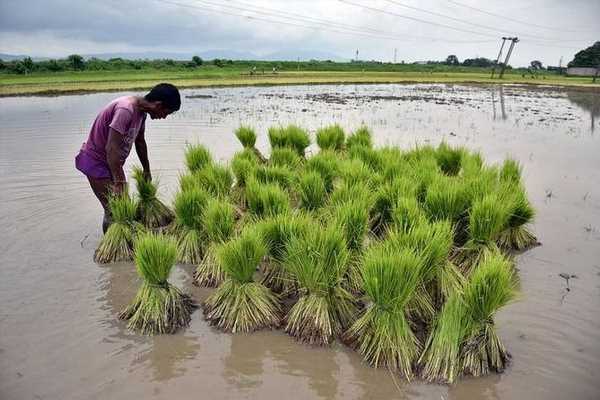Falling paddy acreage sparks concerns
The area under paddy — the biggest foodgrain during the kharif season — was almost 13 per cent lower in the week ended August 5 as compared to the same period last year despite a slight pick-up in rains in the main growing regions, triggering fears of a 10-12 million-tonne drop in final output.
Sources said with the peak sowing season for paddy almost coming to an end in the big-growing states, any uptick in coverage from here onwards may not give the desired yields.
With 30 per cent of normal average area in which paddy is grown every year remaining unsown till early August, there is a limited chance of a big uptick in output, trade and market sources said.
In the previous kharif season, India produced over 111 million tonnes of rice.
In several states, farmers have already moved on to other short-duration crops such as pulses and coarse cereals abandoning paddy.
According to the India Meteorological Department (IMD), between June 1 and August 8, the southwest monsoon is around 7 per cent more than normal (cumulatively across the country).
However, in major paddy-growing states of UP (-40 per cent), West Bengal (-25 per cent), Jharkhand (-48 per cent), Bihar (-35 per cent) and Odisha (-9 per cent), the rains are woefully short.
Together, the five states account for more than 40 per cent of India’s total annual rice production, estimated to be over 120 million tonnes.
Less paddy acreage has been reported from West Bengal (1.2 million hectares), Jharkhand (0.93 million hectares), Bihar (0.48 million hectares) and Chhattisgarh (0.43 million hectares).
The situation is similar in Uttar Pradesh (0.38 million hectares), Madhya Pradesh (0.37 million hectares), Odisha (0.35 million hectares) and Telangana (0.28 million hectares).
India, the world’s second-largest producer and top exporter of rice, commands a 40 per cent share in global rice trade.
It exported 21.2 million tonnes of rice in 2021-22, of which 3.94 million tonnes was the basmati variety.
The weekly data also showed that apart from paddy, area sown under pulses is down marginally to 11.64 million hectares down from 11.94 million hectares.
However, the acreage under coarse cereals, oilseeds, cotton, sugarcane and jute as well as mesta is higher till August 5, 2022, as compared to last year.
For most crops, the sowing is almost over.
Data showed that the acreage of coarse cereals increased to 16.03 million hectares up from 15.44 million hectares.
Oilseeds sowing area was up at 17.47 million hectares till August 8, from 17.38 million hectares last year.
Cotton sowing increased to 12.12 million hectares, up from 11.35 million hectares.
Total area under coverage for all kharif crops was down at 90.86 million hectares till August 5, against 93.66 million hectares during the same period last year.
On the back of bumper production and high procurement in the last few years, the Centre is sitting on a stock of 47 million tonnes of rice (including rice equivalent of unmilled paddy) as on July 1.
This is against the buffer norm of 13.5 million tonnes.
The Centre can use rice from its own godowns to intervene in the market, in case of price rise.
Already, the Centre is supplying more rice instead of wheat through ration shops.
This is because its procurement of wheat fell sharply to 19 million tonnes this year from 43 million tonnes last year.
Armed with high levels of stock in the central pool, the government is providing rice at Rs 3 per kg under the food law and free of cost under the Prime Minister Garib Kalyan Anna Yojana (PMGKAY) to around 800 million people, incurring huge amounts of subsidy.
The PMGKAY is valid till September and it will be interesting to see whether the government further extends it or not, given the tight stock situation in wheat.
Source: Read Full Article


